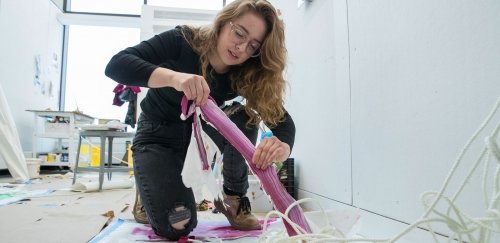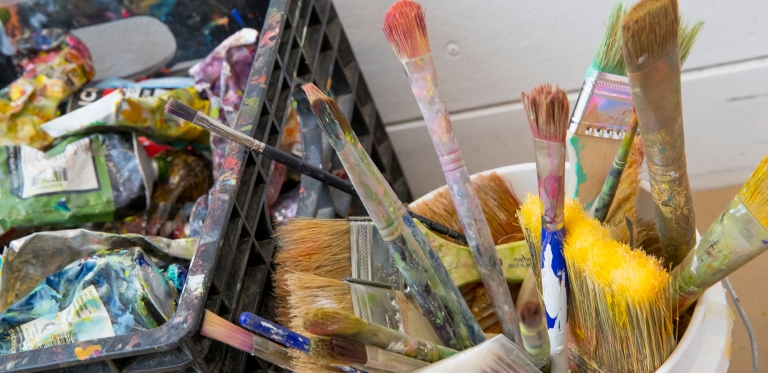
A DeStefano research scholarship allows DeAngelis to explore the latent quality in materials
First Jenna DeAngelis mixes acrylic paint (made of water and plastic) on a palette. She then brushes it onto a flat surface, lets it dry and peels it away from the surface. At that point she can stretch, twist, roll and otherwise manipulate the paint with latex for her own purposes. It is one of the ways this painter is venturing into the 3-D world of sculpture with the help of the Anne & Bob DeStefano Undergraduate Research Scholarship. A college honors student, DeAngelis is making use of the funds to purchase materials for her unusual project.
"I'm a painting major but my focus is process," DeAngelis said. "To me, process is the most important part of making art. I think that's when you begin to understand the latent qualities in the materials you use."
Her research focuses on investigating materials. She is introducing herself to materials she's never worked with before – latex, rope, gampi and kitakata paper and using them to create sculptural pieces that "behave like the human body when they're hung, stained, attached and layered."
"I think the human body is really leaky and messy," she explained. "We're embarrassed by our natural bodily functions and behaviors. Because we feel vulnerable, we cover them up. I want to expose them."
But like all process artists, DeAngelis' greatest enjoyment comes from the act of creating itself, the experience of discovering the untapped qualities in her materials, the active play with materials.

Her faculty mentor is Associate Professor of Art Juan Barboza-Gubo. "He's a great mentor because he supports investigation," she said, "and he truly values the thinking that goes behind a work. He pushes me conceptually."
DeAngelis meets with Barboza-Gubo multiple times a week. "He talks to me about where my process is going and how to take an idea and make it into a piece. An exciting outcome of my research is that I'm a painter who hasbecome more sculptural. I now see paint as a visceral pile of color," she said.
So far DeAngelis has created four pieces and will soon begin work on her research paper. She will examine art history movements focused on process, such as abstract expressionism and post-minimalism, and discuss specific artists, their work and their process, like painter turned sculptor Eva Hesse.
DeAngelis is a very thankful recipient of the DeStefano research scholarship. "The scholarship not only allowed me to purchase materials for my project – I go through a lot of paint," she said, with a smile, "it also allowed me time to figure out how to make a body of work; how to organize my intention so that it is clear, powerful and effective; and to really take the time to think about what I am doing as an artist."
DeAngelis' project began in fall 2018 and will be completed this spring at which time she will present her research paper and her finished pieces and discuss them before a faculty panel at an honors review.
"We have a lot of terrific students who want to go deeper and they don't always necessarily know how," said Director of College Honors and Professor of Mathematics Rebecca Sparks. "Being able to engage in in-depth research and present their work at a conference or publish their work in a professional journal can really dramatically change their trajectory."
